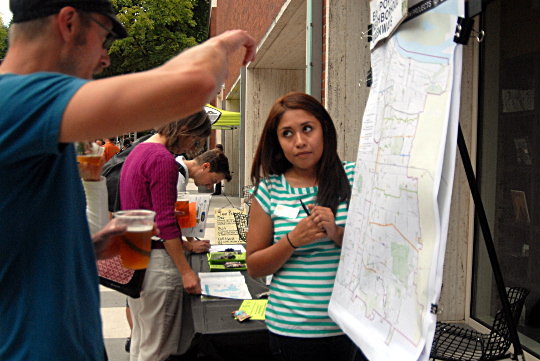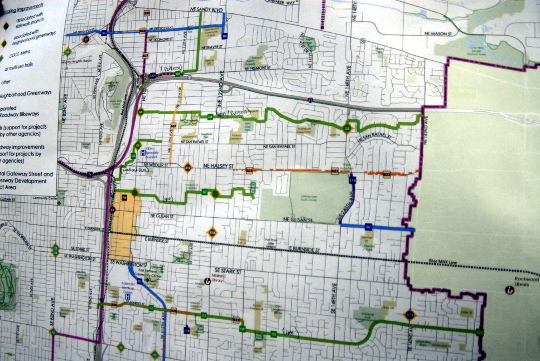
(Photos: M.Andersen/BikePortland)
Fourth in a week-long series about the BTA’s five new advocacy campaigns.
Of the five new Bicycle Transportation Alliance advocacy campaigns we’re examining this week, the only one that’s almost certain to succeed is east of Interstate 205.
That’s because it represents official BTA backing for five new stretches of a relatively cheap, uncontroversial type of bikeway — neighborhood greenways, the low-traffic side streets that have sharrows, speed bumps, 20 mph limits, wayfinding and comfortable crossings of major streets — that are already enshrined in the city’s popular East Portland in Motion plan and already have the support of the extremely effective advocates at the East Portland Action Plan.
That’s not to say East Portland advocates aren’t glad to have the BTA’s help improving these 12 miles of streets.
“We’re just really pleased that it is on their top agenda,” EPAP Advocate Lore Wintergreen said in an interview.
Wintergreen, who managed the city’s Safe Routes to School program before becoming a full-time advocate for East Portland, said she’d been reminded of the importance of basic, safe bikeways east of I-205 when she’d been headed home via Northeast Halsey, a key east/west freeway crossing that has no bike lanes.
“In midday, so we’re talking about 3:30, I counted 15 bike riders,” she said. “And looking at the faces of those bike riders, they were diverse people.”
Five connections to the spine: I-205
All five greenways in the BTA’s and EPIM’s sights all plug into the I-205 path and therefore the TriMet Green MAX Line. Here are the descriptions, taken from the city’s East Portland in Motion document:
Parkrose: Connecting the 205 path and Gateway Green (between I-205 and I-84) to NE Sandy and 115th, including a new multi-use path on the south side of Fremont between 102nd and 112th.
Knott/Russell: Connecting NE Knott and 102nd to NE 162nd and Russell, past the University of Western States, Margaret Scott Elementary and the Summerplace assisted living community. This would include crossing improvements at 102nd, 122nd and 148th.
Woodland Park: Connecting NE 99th and Multnomah, near Gateway Transit Center, north-northeast through the currently auto-oriented commercial area to NE Tillamook and 108th, including two short protected bike lane connections and an offset crossing improvement at 102nd.
4M: One of the biggest missing pieces in East Portland infrastructure, this 4.2-mile greenway would run along Market, Mill, Millmain and Main from the I-205 path past David Douglas high school to the city limit just past SE 174th.
Holladay Oregon Pacific: This route weaves from Gateway Transit Center, past Winco, on the neighborhood streets south of Halsey east to the 130s Greenway and Holladay Park East. It’d include crossing improvements at Pacific and 102nd and Holladay and 122nd.
Thanks to years of advocacy from East Portlanders, the city seems to be strongly behind all these improvements: when the Portland Bureau of Transportation released a list of possible projects to be associated with its proposed street fee, these five were the top of the list.
Elizabeth Quiroz, the BTA’s lead staffer on this project, said this month that getting these projects done is mostly a matter of finding the money. She expects a wave of state support to greatly improve biking and walking along Southeast Powell; for the moment, these greenways are the counterpart to that work on the north side of East Portland.
Advertisement
Quick take: BikePortland’s summary of the project
Where the idea came from: East Portland neighborhood advocates wrestled these routes into Portland’s 2010 bike plan, but they’ve been delayed by the city’s decision to slice funding for neighborhood greenways. Wintergreen, the city-paid advocate for East Portland investments, has coordinated volunteers and coalition partners including the BTA to get them funded.
What it might cost: Quiroz estimates the total cost at $2,290.000.
Obstacles: If Mayor Hales and Transportation Commissioner Steve Novick can find a third vote on Portland City Council for a street fee or similar revenue proposal that includes “safety” as well as “maintenance” improvements, these look like a shoo-in sometime in the next few years. If not, they’ll join the ongoing scramble for state and federal grants. But Wintergreen predicts that there’s a “100 percent” chance that these will all be complete within five years, one way or another.
How you could help: Contact Quiroz: 971-231-5686, elizabeth@btaoregon.org, or the EPAPbike Subcommittee.
Check back next week for the final post in our series about new advocacy campaigns.



